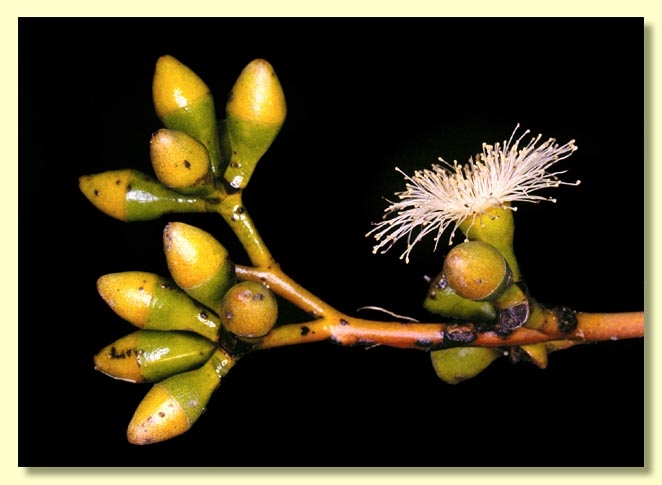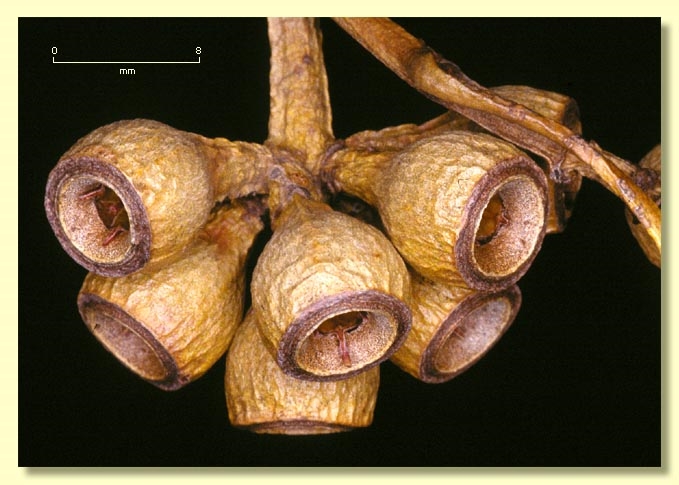Eucalyptus | Symphyomyrtus | Bisectae | Destitutae | Porantherae | Longiores
Euclid - Online edition
Eucalyptus sp. Kalbarri
This taxon was referred to as Eucalyptus aff. rigidula in earlier editions of EUCLID.
Bark smooth throughout, grey to grey-green and brown-grey.
Branchlets lacking oil glands in the pith.
Juvenile growth (coppice or field seedlings to 50 cm): stems rounded in cross-section; juvenile leaves sessile, opposite to sub-opposite, ovate to narrow oblong, 3.5–6 cm long, 2–3 cm wide, green.
Adult leaves stiff, ± erect, alternate, petioles 0.5–2 cm long; blade elliptic-lanceolate, 6.5–10.5 cm long, 0.8–1.5 cm wide, base tapering to petiole, margin entire, apex pointed, concolorous, glossy, green, side-veins at an acute or wider angle to midrib, reticulation dense, intramarginal vein present, oil glands few, intersectional or ?absent.
Inflorescence axillary unbranched, peduncles slightly flattened, 0.5–1.5 cm long, buds (?7)9 or 11, pedicellate, pedicels stout 0.2–0.5 cm long. Mature buds ovoid to fusiform (0.7–1.4 cm long, 0.3–0.5 cm wide), scar present, operculum conical to beaked (0.4–0.7 cm long), stamens inflexed, anthers cuneate-cuboid, adnate to filament apex (rigidly basifixed), dehiscing by sub-terminal pores, a few of the innermost stamens imperfectly formed, style long and straight, stigma tapered, locules 3, the placentae each with 4 vertical rows of ovules. Flowers creamy white.
Fruit pedicellate, pedicels 0.1–0.4 cm long, cupular to stoutly barrel-shaped, 0.5–0.8 cm long, 0.5–0.8 cm wide, disc usually descending, valves 3, more or less enclosed.
Seeds brown, 1–2.5 mm long, flattened-ovoid, dorsal surface sometimes with longitudinal furrows, scarcely reticulate, hilum ventral.
Cultivated seedlings (measured at node 10): cotyledons Y-shaped (bisected); stems rounded or square in cross-section, maybe slightly warty; leaves sessile, opposite for ca 13–15 nodes, ovate to lanceolate or elliptical, then becoming alternate and shortly petiolate, 2.5–7 cm long, 1–2.5 cm wide, grey-green, dull.
Flowering time unknown.
Smooth-barked mallees occurring in Western Australia on the coastal sandplain in the Eurady, Kalbarri–Geraldton area, probably extending south to Calingiri and near Wongan Hills.
These plants are closely allied to E. rigidula. However, they have slightly larger fruit than E. rigidula whilst seedling and juvenile leaves are ovate-lanceolate, dull greyish green and remain opposite for more nodes than in typical E. rigidula. The juvenile and seedling leaves of typical E. rigidula quickly become linear-lanceolate and glossy green. E. sp. Kalbarri is imperfectly known and worthy of further study.
Eucalyptus sp. Kalbarri would best be placed in Eucalyptus subgenus Symphyomyrtus section Bisectae subsection Destitutae because the buds have two opercula, cotyledons are Y-shaped and branchlets lack oil glands in the pith. Within this subsection E. sp. Kalbarri belongs to a group of about 16 species, series Porantherae, that are further characterised by having anthers completely adnate to the staminal filaments, strongly inflexed stamens, densely reticulate leaves with intersectional oil glands and by the fruit with a distinct thick rim that includes a whitish descending disc. With all species in series Porantherae it is necessary to have seedling charateristics to accurately make an identification, so if working with this group be prepared to grow them!











